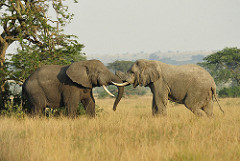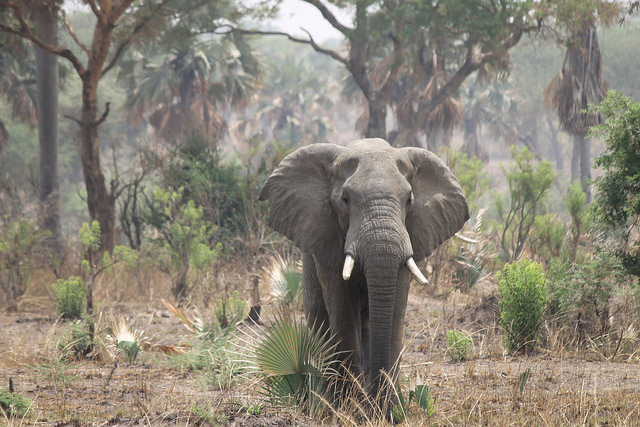Quick Answer: Elephants Are Diurnal and Kinda Crepuscular.
But this really doesn’t do the topic justice. Elephants are interesting because of the fact that they sleep so little; they have a very unique circadian rhythm. This makes answering this topic tricky, but I will go into this more later.
What Time of Day Are Elephants Most Active?
Elephants are active both day and night, although they usually show a period of inactivity in the heat of the day. They generally only sleep while lying down at night. Feeding rates may vary between different times of the day. (Twycrosszoo, 2018)
Are Elephants Crepuscular?
Yes. Crepuscular animals are those that are active primarily during twilight (dawn and dusk). Major feeding bouts take place in the morning, afternoon and night. At midday, elephants rest under trees and may doze off while standing.
The hotter it is, the faster the elephants will flap its ears. On a windy day, however, an elephant may find it easier to stand and face into the wind and hold its ears outward to take advantage of the breeze. (Telegraph, 2001)
Are Elephants Nocturnal?
Yes and no. Nocturnal animals are those that are active primarily during the night. This helps most nocturnal animals avoid predators. Elephants do sleep a few hours a night. But they do not get much sleep, only around 2-4 hours (in the wild). I get this 2-4 hour figure from multiple sources that are listed at the bottom of the page. Most sources say 2 hours, one says 4. Either way, there will be some variability among individuals and different herds. Captive elephants sleep more than this, clocking in at around 4-6 hours a night.
Night or day, elephants need to eat a lot of food:
They may feed for up to 16 hours a day. In the wild one animal can consume as much as 600 pounds of food in a single day, although 250 – 300 pounds is a more typical amount. In a zoo, an average adult elephant may eat 4-5 bales of hay and 10 – 18 pounds, or 4.5 to 8 kg, of grain a day. This amounts to a yearly quantity of more than 29,000 kg of hay and 2700 kg of feed per animal. The normal daily water consumption of an elephant is between 25 – 50 gallons per animal, or 100 – 200 liters (Meadows, 2017)
Are Elephants Diurnal?
Yes. Elephants are active during daytime. They tend to move around during the day except when it is incredibly hot outside.
Are Elephants Matutinal?
Yes, because matutinal animals are active in the morning and elephants are considered crepuscular.
Are Elephants Vespertine?
Yes, because vespertine animals are active at sunset. As a crepuscular animal, elephants may be considered vespertine.

Elephant Sleeping Facts:
Elephants have many ways of sleeping. They will lie on the ground, rest their foreheads, tusks or trunks against strong trees, or lean against termite mounds. However, they don’t have time to sleep very much. They are non-ruminant herbivores, this means they do not chew cud, ruminate or belch as ruminant animals (e.g., cattle, bison, goats, deer) do; instead they produce methane gas. Properly equipped, a car could travel 20 miles on the amount of methane produced by one elephant in a single day…
… In total, wild elephants will accumulate about 2-4 hours of sleep in 24 hours, generally at night and sometimes during the heat of the day – although baby elephants may have a longer circadian clock. When a baby elephant sleeps, its mother will stand guard watching for predators. Within a breeding herd, the animals will take turns sleeping to ensure the safety of the group. An elephant that lives for 60 years will sleep for about 16% of its lifetime (Telegraph, 2001)
Do Elephants Sleep Standing Up?
Yes. It would be difficult for for an elephant to get enough sleeping hours in otherwise.
Why Do Elephants Sleep Standing Up?
Mammals lose tone in their skeletal muscles during REM sleep. So for an elephant to have REM sleep it needs to lie down. Without any muscle tone, it is challenging to stand unless they’re resting against a tree or a large rock.
The elephant’s body has some special features because it is so large and heavy. The skull, parts of which are six inches thick, contains many air spaces making the inside appear something like a honeycomb or sponge. This adaptation has allowed the skull to grow to a large size without enormous weight. The legs of an elephant are in an almost vertical position under the body, like the legs on a table. This design provides strong support for the massive body that the legs have to carry. It also allows elephants to sleep standing up without the risk of their legs buckling (Manger, 2017) (FACTS, 2018)
Do Different Species of Elephants Have Different Sleeping Patterns?
They seem to be pretty similar. The African bush elephant (Loxodonta africana), the African forest elephant (Loxodonta cyclotis), and the Asian elephant (Elephas maximus) have a maximum of 2-4 hours for sleeping at night in nature. Captive animals may sleep up to four to six hours.
How Long Do Most Elephants Sleep?
According to zoologists, elephants in captivity (zoos), sleep during the night for four to six hours. However, in natural habitats, they only sleep for 2-4 hours during the night.
In fact, the leader of the group may sometimes stay awake for several days. Many elephants in the herd will only enter deep sleep when other elephants are on the lookout. We know elephants are in this cycle of deep sleep thanks to the presence of rapid eye movement. This REM sleep only seems to happen when the elephant is lying down and doesn’t seem to occur while the elephant is standing. (Briggs, 2017)
Elephants As Landscape Engineers
Where we find elephants, we can see major changes in the shape of the lands. If they dig holes into the ground, other animals can use those holes as water collection devices. Even more, when they excavate in the mountains or hills or the ground, it’s later used by birds as a nest.
They also have a massive role in the pollination process, as they take in seeds with their prehensile trunk and disperse it into the air in vast quantities. This point in the germination process isn’t filled by other animals. So, when you are in elephant country and you see a hole in the ground ( or a flower), you can thank the ever helpful elephant!

Conclusion
Elephants have a huge impact on the environment. In ecology, they are known as key species, meaning they are affecting an extensive range of animals as was alluded to in the beginning of this article.
Elephant sleeping patterns really stand out in the animal kingdom. It is one of the fantastic facts of biology that a creature so large could require so little sleep. The elephants lack of sleep stands in stark contrast to its reputation for having a great memory.
The continuous feeding habits and movement of elephants play a vital role in the physical shaping of the savannah. Next time you are looking at a serene savannah, try and see all the hidden, and mysterious patterns that shape it. Try to imagine how many other crazy and obscure facts lie hidden within the tall savannah brush.
Title feature image source
References
- Briggs, H., 2017. Mysteries of elephant sleep revealed. [Online]
Available at: https://www.bbc.com/news/science-environment-39126993
[Accessed 4 Dec 2018]. - FACTS, S. S. W., 2018. SABI SABI WILD FACTS: HOW THE BIG ONES SLEEP. [Online]
Available at: https://www.sabisabi.com/wildfacts/how-the-big-ones-sleep/
[Accessed 4 Dec 2018]. - Manger, P., 2017. Why it’s so important to understand how elephants sleep. [Online]
Available at: https://theconversation.com/why-its-so-important-to-understand-how-elephants-sleep-74780
[Accessed 4 Dec 2018]. - Meadows, R., 2017. African elephants sleep only two hours a day. [Online]
Available at: http://researchnews.plos.org/2017/03/01/african-elephants-sleep-only-two-hours-a-day/
[Accessed 4 Dec 2018]. - Telegraph, 2001. Elephant Interesting Facts. [Online]
Available at: https://elephantconservation.org/elephants/just-for-kids/
[Accessed 4 Dec 2018]. - Twycrosszoo, 2018. African Elephant – Loxodonta africana. [Online]
Available at: http://wildpro.twycrosszoo.org/S/0MProboscidae/Elephantidae/Loxodonta/Loxodonta_africana/15LoxAfrBehActivity.htm
[Accessed 4 Dec 2018].
